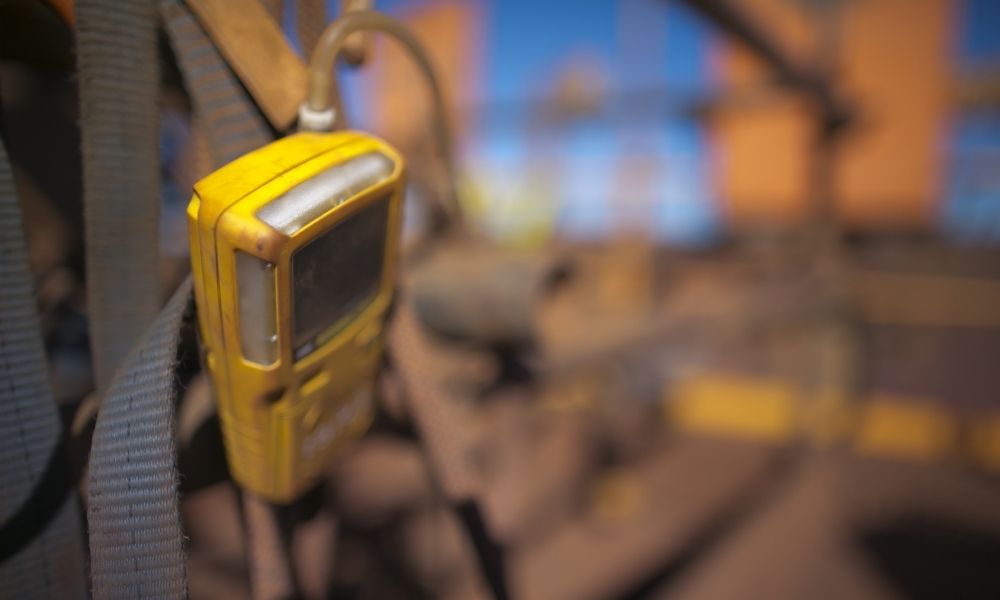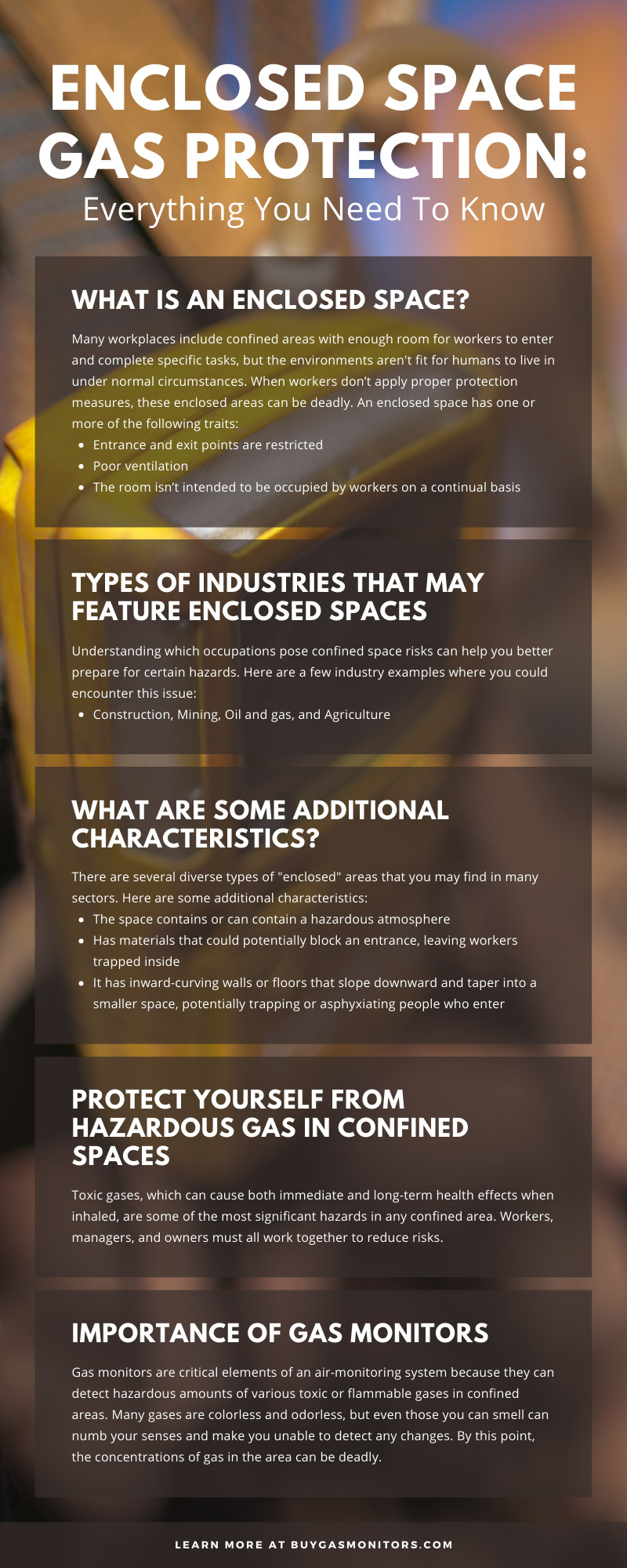Enclosed Space Gas Protection: Everything You Need To Know
Posted by William Kimmell on 1st Nov 2021

Working in confined spaces is a necessity in a variety of industrial professions. As a result, you must protect yourself and your coworkers from the hazards that exist in these situations. Continue reading to discover everything you need to know about enclosed space gas protection.
What Is an Enclosed Space?
Many workplaces include confined areas with enough room for workers to enter and complete specific tasks, but the environments aren't fit for humans to live in under normal circumstances. When workers don’t apply proper protection measures, these enclosed areas can be deadly. An enclosed space has one or more of the following traits:
- Entrance and exit points are restricted
- Poor ventilation
- The room isn’t intended to be occupied by workers on a continual basis
What Are Some Additional Characteristics?
There are several diverse types of "enclosed" areas that you may find in many sectors. The Occupational Safety and Health Administration (OSHA) provides precise definitions that can help you figure out what sorts of safety precautions you should take. Here are some additional characteristics:
- The space contains or can contain a hazardous atmosphere
- Has materials that could potentially block an entrance, leaving workers trapped inside
- It has inward-curving walls or floors that slope downward and taper into a smaller space, potentially trapping or asphyxiating people who enter
- Has any other known safety or health threats, such as exposed live wires, unprotected machinery, or excessive heat
Types of Industries That May Feature Enclosed Spaces
Understanding which occupations pose confined space risks can help you better prepare for certain hazards. Here are a few industry examples where you could encounter this issue:
- Construction
- Mining
- Oil and gas
- Agriculture
Construction
The construction field routinely makes use of enclosed spaces that can pose a risk to workers. In fact, OSHA has issued a separate standard specifically for workers in this sector. Some examples of confined spaces in construction include maintenance holes, sewers, storm drains, crawl spaces, water mains, and HVAC ducts.
Mining
One of the most recognizable closed spaces in this sector is underground mining, where workers travel below the Earth's surface to excavate. Mines often contain many hazardous gases, such as carbon monoxide, hydrogen sulfide, methane, and carbon dioxide. Because of the restricted conditions, these gases cannot escape, building within the mine and posing a flammable, explosive, or toxic risk to the workers inside.
Oil and Gas
Oil and gas workers often need to enter restricted spaces, including petroleum and other storage tanks, mud pits, reserve pits, sand storage units, as well as other closed quarters. Highly flammable vapors or gases can ignite in these restricted areas, posing a safety risk. There are also respiratory hazards, including exposure to hydrogen sulfide, drilling fluids, and mercury vapor.
Agriculture
Toxic fumes or low oxygen atmospheres are commonplace in many confined areas on farms. Vapors, poisonous gases, dust, or low oxygen levels can suffocate a person in silos, vats, tanks, wells, manure pits, and other enclosed or partially enclosed buildings. When you run a generator to power equipment, you can also risk carbon monoxide poisoning in poorly ventilated areas.
Protect Yourself From Hazardous Gas in Confined Spaces
Toxic gases, which can cause both immediate and long-term health effects when inhaled, are some of the most significant hazards in any confined area. Workers, managers, and owners must all work together to reduce risks.
What Are the Enclosed Gas Hazards?
Here are several of the most significant atmospheric hazards that occur in confined and enclosed spaces.
Oxygen Deficiency
An oxygen-deficient atmosphere describes any place that contains less than 19.5 percent oxygen by volume and can occur when there is potential for high gas concentrations other than air. Even nonflammable or nontoxic gas can choke enough surrounding air to lower oxygen levels to the point where it's unsafe for you to enter. Low oxygen levels can cause poor judgment, loss of coordination, changes in behavior, dizziness, tiredness, and even death.
Flammable Atmosphere
Many gases can be explosive when they're present at certain concentrations. Combustible gas explosions frequently occur when the restricted area is first unsealed or disrupted. Methane (CH4) is the most common flammable gas found in confined spaces and can come from the microbial breakdown of things such as sewage and rotting plants.
Toxic Atmosphere
Toxic gases are gases that are poisonous to living organisms. When you encounter these gases in manufacturing or other industrial processes, they can quickly build up in confined working spaces. Carbon monoxide (CO) and hydrogen sulfide (H2S) are the most common hazardous gases found in confined spaces.
Importance of Gas Monitors
Gas monitors are critical elements of an air-monitoring system because they can detect hazardous amounts of various toxic or flammable gases in confined areas. Many gases are colorless and odorless, but even those you can smell can numb your senses and make you unable to detect any changes. By this point, the concentrations of gas in the area can be deadly.
Implementing a gas monitor that is sensitive to the gases typically present in your industry is the only way to figure out if an area has an unsafe quantity of hazardous gases. Gas monitors show atmospheric dangers on a worksite below the defined exposure limits. You need to properly train workers on how to use them for these gas monitors to be effective.
Stationary Gas Detection
You can permanently install fixed gas detection systems in confined areas to provide continuous space and personnel protection 24 hours a day, seven days a week. They warn employees who enter these areas about the risk of illness and death from toxic gas exposure, asphyxiation from a lack of oxygen, or explosion from flammable gases.
Portable Gas Detectors
The most significant advantage of portable gas detectors is that you can carry them with you on your clothing wherever you go. They have sensors installed to detect flammable gas, low oxygen levels, carbon monoxide, and hydrogen sulfide. These devices also generally have built-in alarms intended to protect you and monitor employees in tight places.
We hope this guide has helped shed light on everything you need to know about enclosed space gas protection. TG Technical Services offers the highest quality portable and stationary gas detectors to keep you and your fellow employees safe from atmospheric dangers in enclosed environments. Feel free to contact us with any questions about our products.


